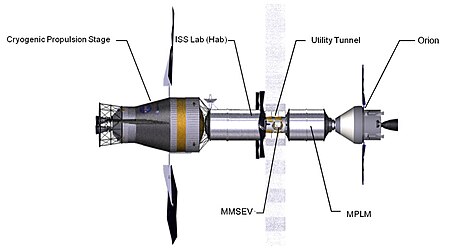
500 day HAB/MPLM with Cryogenic Propulsion Stage
Deep Space Habitat (DSH) is a 2012 proposed NASA conceptual design to support a crew of 4 for exploration beyond Low Earth orbit. Initial concept missions include 60 day and 500 day mission configurations, composed of International Space Station-derived hardware, the Orion crew capsule and various support craft.[1] The Habitat would be equipped with at least one International Docking System Standard (IDSS) docking system. Developing a Deep Space Habitat would allow a crew to live and work safely in space for up to one year on missions to explore cis-lunar space and some near-Earth asteroids. It would also provide experience favorable for designing longer-duration habitats that could be used for manned missions to Mars and more distant asteroids.
Configurations[]

ISS-derived Deep Space Habitat HAB/MPLM

ISS-derived Deep Space Habitat MPLM/Node1
HAB/MPLM[]
- 60 Day Mission - The basic 60 day mission variant would consist of a Cryogenic Propulsion Stage (CPS), ISS Destiny-derived lab module, and an airlock/tunnel. In addition, a mission-specific support craft, such as the FlexCraft or the Multi-Mission Space Exploration Vehicle (MMSEV) would be docked to the airlock/tunnel. The Destiny-derived lab houses both the crew quarters and the ECLSS components.[citation needed]
- 500 Day Mission - The 500 Day mission variant would consist of the same 60 day crew habitat and crew size. Mass increases would result from the addition of a Multi-Purpose Logistics Module (MPLM) to provide additional supply storage for the extended mission duration.[1] It would be 56 feet long, with a diameter of 16 feet, not including the CPS.[citation needed]
MPLM/Node 1[]
- 60 Day Mission - The basic vehicle elements for this configuration would include a CPS, a MPLM, Utility tunnel/airlock, Node 4 Structural Test Article. The Node element would allow for the attachment of more than one FlexCraft or Space Exploration Vehicle (MMSEV). The Habitat would be crew serviceable at the front of the Node element opposite the tunnel.[citation needed]
- 500 Day Mission - This 500 day mission variant would have a second MPLM attached to the front on the vehicle as well as add a Cupola to the Node section.[citation needed]
Support craft[]

MMSEV
- Orion - NASA designed and currently under construction deep space manned capsule. Capable of carrying 4 crew, and able to withstand re-entry speeds from lunar or Martian trajectories. Orion will be used mainly for crew rotation.
- MMSEV - NASA designed servicing craft. Capable of supporting 2 crew and having externally attached EVA suits. It is also capable of free flight for 2 weeks. The vehicle has its own lavatory.
- DSH FlexCraft - a single crew vehicle, attached to the DSH similar to a visiting craft to the International Space Station.
Propulsion options[]
Propulsion options studied included:[citation needed]
- Cryogenic Propulsion Stage - Traditional high-thrust propulsive stage likely using liquid hydrogen/liquid oxygen-fueled engines.
- Space Electric Propulsion - This propulsion system takes advantage of the high efficiency of Hall effect thrusters or other emerging ion-plasma thrusters
See also[]
- Exploration Gateway Platform
- Nautilus-X
References[]
- Constructing Next-Generation Space Habitat Demonstrators, spacefellowship.com
- Deep Space Habitat module concepts outlined for BEO exploration
- Deep Space Habitat Configurations (Based on International Space Station Systems), AES Habitation Project, March 2012
Template:Space stations
| This page uses Creative Commons Licensed content from Wikipedia (view authors). | 
|